0 引言
煤自燃是矿井火灾的主要致因之一[1]。煤自燃时会产生大量热、烟尘、CO等[2-3],对井下人员生命安全造成极大危险。水分是影响煤自燃的一个不可忽略的因素[4-5]。近年来,众多学者在水分对煤自燃影响方面做了较多研究。李峰等[6]通过热重实验,得出水浸煤比原煤表现出更强的氧化升温速率,具有更强的自燃倾向性。王亚超等[7]研究了无烟煤在不同水分含量条件下放热特性的变化规律,结果表明煤样的初始放热温度随水分含量的增加先减小后增大,总放热量先增大后减小。贾廷贵等[8]通过热重和差示扫描量热法联用实验,分析了煤中水分含量对煤自燃过程失重特性与放热特性的影响,结果表明煤中水分含量增加会抑制煤氧复合过程,煤自燃失重量随着水分含量的增大而减小,放热量随水分含量的增加而降低。徐长福等[9]测试了不同含水率煤样在氧化自燃过程中CO与C2H4生成量,并基于CO浓度求解了煤自燃临界温度,指出煤自燃临界温度随着煤含水率增大先增大后减小再增大。翟小伟等[10]研究了水分对煤孔隙及自燃特性的影响,建立了不同含水量对煤自燃影响程度的鉴定准则及评价指标,得到不同含水量对煤自燃促进或抑制作用的阶段划分及临界含水量范围。本文采用锥形量热仪测试不同水分含量条件下煤在燃烧过程中的点燃时间、热释放速率、总热释放量、烟气生成速率、总烟释放量、CO生成速率等,得到不同含水率煤的燃烧特性。
1 实验方法
1.1 煤样制备
实验煤样取自中安联合煤化有限责任公司朱集西煤矿11502综采工作面,煤种为中等变质程度的烟煤,其工业分析结果见表1。将剥去氧化层的新鲜煤块用研磨机和筛煤机在N2气氛中进行破碎并筛分出粒径为0.10~0.15,0.15~0.20,0.20~0.30 mm的煤样,密封保存。选取3种不同粒径煤样各20 g,制成5组(每组60 g)混合煤样,将混合煤样在真空干燥箱内干燥24 h后,用透明喷壶均匀喷洒蒸馏水到煤样中,添加水分后的煤样放入密封袋中抽掉空气,放置在阴冷环境中7 d,使得煤体孔隙和裂隙中充分浸入水分,制成含水率分别为5.82%,9.82%,13.82%,17.82%的煤样。
表1 煤样工业分析结果
Table 1 Industrial analysis results of coal samples %
水分灰分挥发分固定碳1.8218.8720.1661.90
1.2 实验过程
实验仪器预热并调试完成后,待锥形加热器加热到所需温度,将称量好的60 g煤样均匀平铺在放有铝箔纸的样品槽(长×宽×高为100 mm×100 mm×10 mm)中,然后将样品槽置于燃烧支架上方进行实验。实验条件:室温为20 ℃,相对湿度为40%,热辐射强度为45 kW/m2。煤样燃烧过程分为热解、燃烧和红热3个阶段,如图1所示。在热解阶段,煤中的水分和挥发物析出,煤样表面出现白色烟雾及微量黑烟,同时有闪燃的现象出现;在燃烧阶段,煤中挥发物和固定碳燃烧,煤样表面出现明亮火焰;在红热阶段,煤中少量的固定碳燃烧,煤样表面出现微量白烟,无明显的明亮火焰。
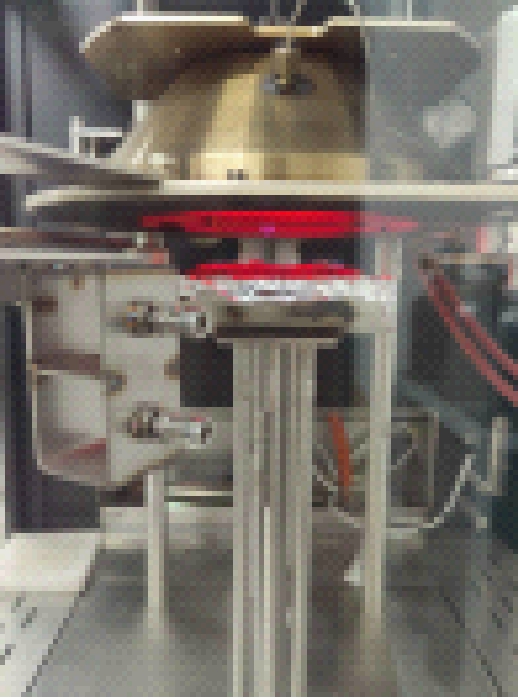
(a) 热解阶段
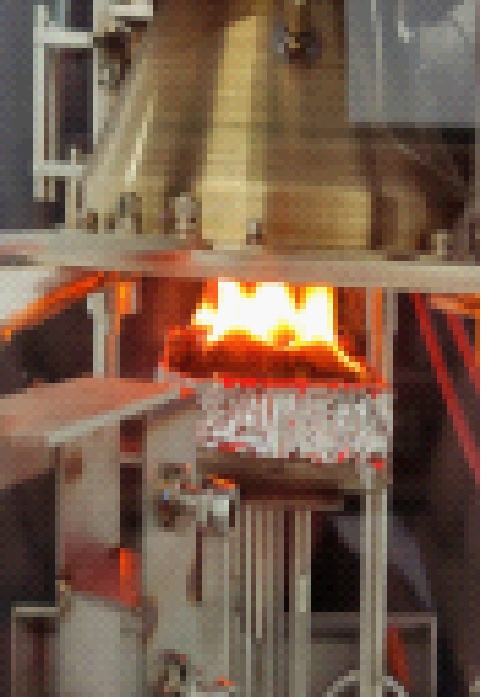
(b) 燃烧阶段
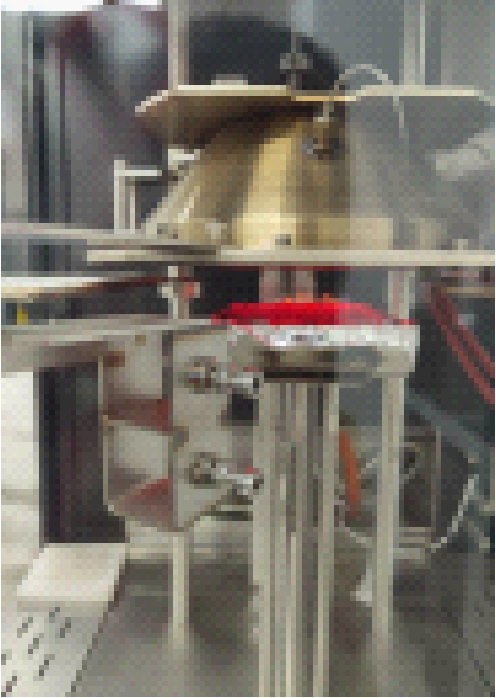
(c) 红热阶段
图1 不同阶段煤样燃烧现象
Fig.1 Combustion phenomena of coal samples at different stages
2 实验结果与分析
2.1 点燃时间
点燃时间是指煤样从暴露于热辐射源开始到表面出现明火为止的时间,反映煤样被点燃的容易程度,点燃时间越短,表明煤样越容易燃烧[11-12]。不同含水率煤样点燃时间见表2,可看出煤样点燃时间随着含水率增大先减少后增加,煤样点燃时间从长到短对应的含水率排序为17.82%>13.82%>1.82%>5.82%>9.82%。
表2 不同含水率煤样点燃时间
Table 2 Ignition time of coal samples with different moisture content
含水率/%1.825.829.8213.8217.82点燃时间/s39322343122
2.2 热释放速率和总热释放量
热释放速率是指在一定的热辐射强度下,单位面积煤样燃烧所释放热量的速率,其峰值可表征煤燃烧时的最大热释放程度[13]。不同含水率煤样热释放速率如图2所示。可看出不同含水率煤样热释放速率变化趋势基本相似,经短暂波动后迅速达到峰值再逐渐下降,最终趋于稳定;煤样热释放速率峰值随含水率增大先减小后增大再减小,煤样热释放速率峰值从大到小对应的含水率排序为9.82%>1.82%>5.82%>13.82%>17.82%;当含水率大于9.82%时,煤样水分含量越高,热释放速率峰值越小且下降越明显;1.82%,5.82%,9.82%,13.82%,17.82%含水率的煤样热释放速率达到峰值的时间分别为40,30,25,45,130 s,煤样在点燃的瞬间其热释放速率达到峰值,其中含水率17.82%的煤样热释放速率达到峰值的时间较长。
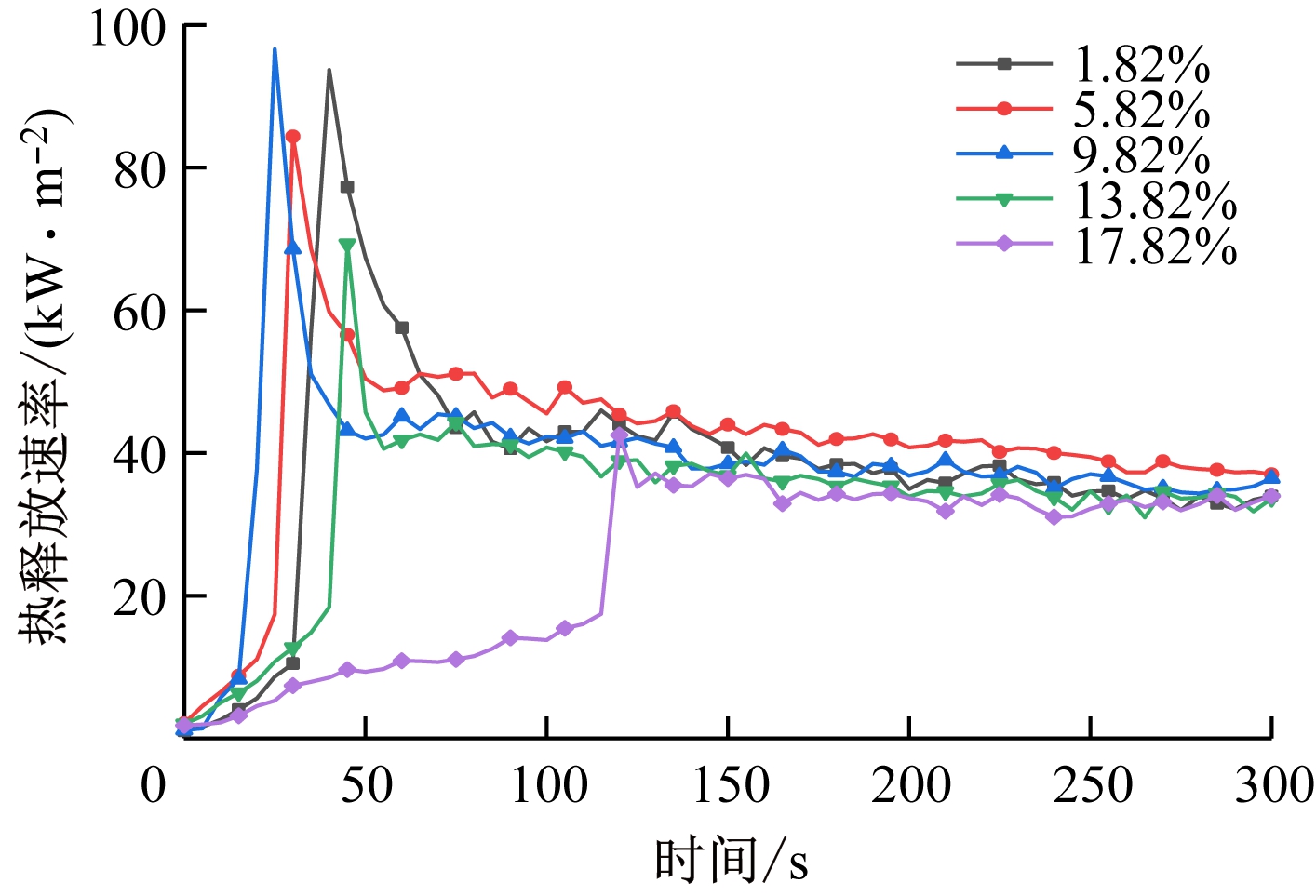
图2 不同含水率煤样热释放速率
Fig.2 Heat release rate of coal samples with different moisture content
总热释放量是指煤样从点燃到熄灭时间内放出的总热量[14]。不同含水率煤样总热释放量如图3所示。可看出煤样总热释放量随含水率增大先减小后增大再减小,煤样总热释放量从大到小对应的含水率排序为1.82%>9.82%>5.82%>13.82%>17.82%;当含水率大于9.82%时,煤样水分含量越高,总热释放量越低。
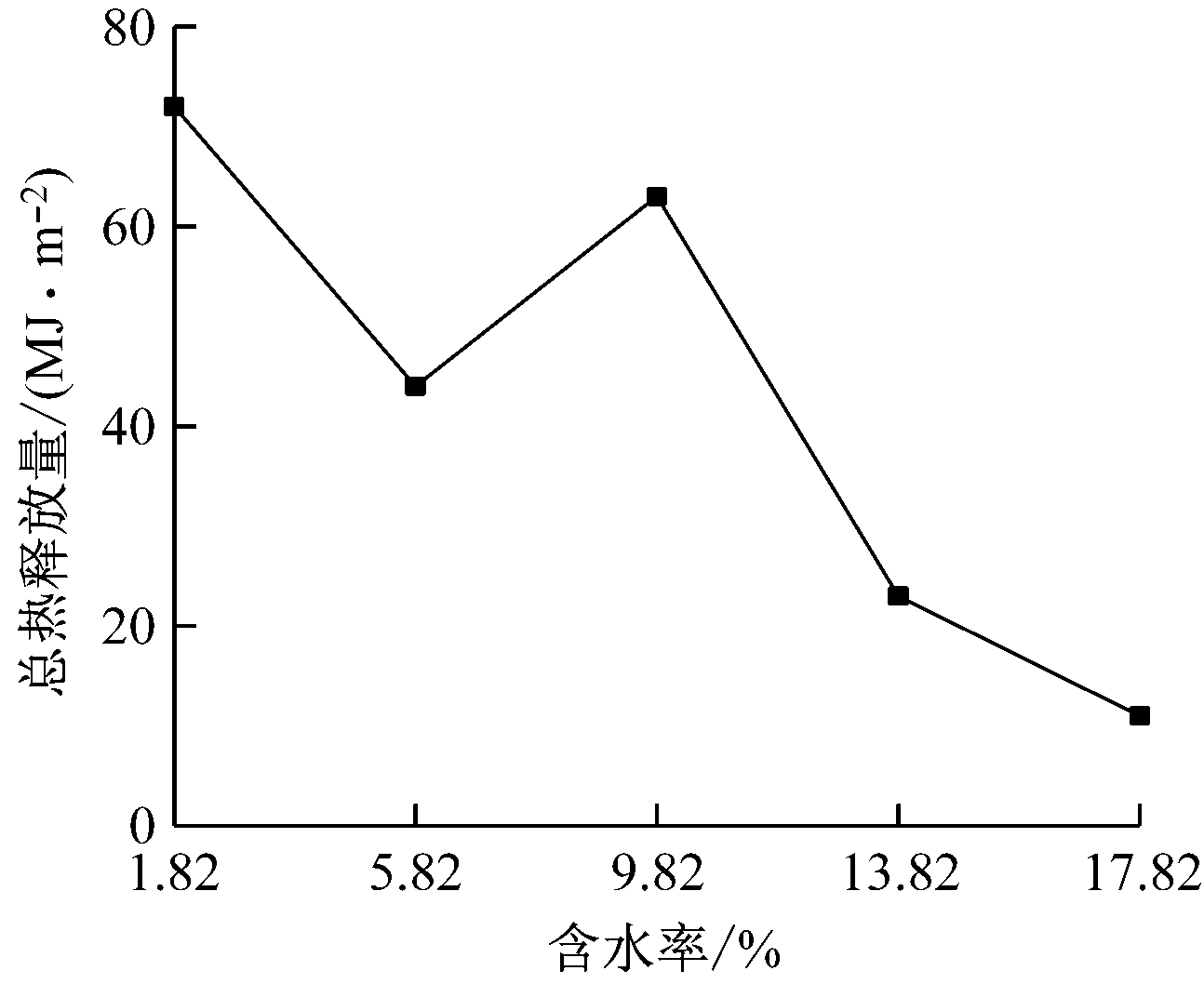
图3 不同含水率煤样总热释放量
Fig.3 Total heat release of coal samples with different moisture content
2.3 烟气生成速率和总烟释放量
不同含水率煤样烟气生成速率如图4所示。可看出不同含水率煤样烟气生成速率变化趋势和热释放速率变化趋势基本一致,即经短暂波动后迅速达到峰值再下降并最终趋于平稳;烟气生成速率在热解阶段与红热阶段几乎为零,这是由于煤样在加热过程中随着温度升高,煤中的自由水、结合水及其气态挥发物质逐渐逸出,煤样从无焰燃烧转换为有焰燃烧,生成透光产物,不透光烟释放速率降低至零;煤样烟气生成速率峰值从大到小对应的含水率排序为1.82%>9.82%>5.82%>13.82%>17.82%。
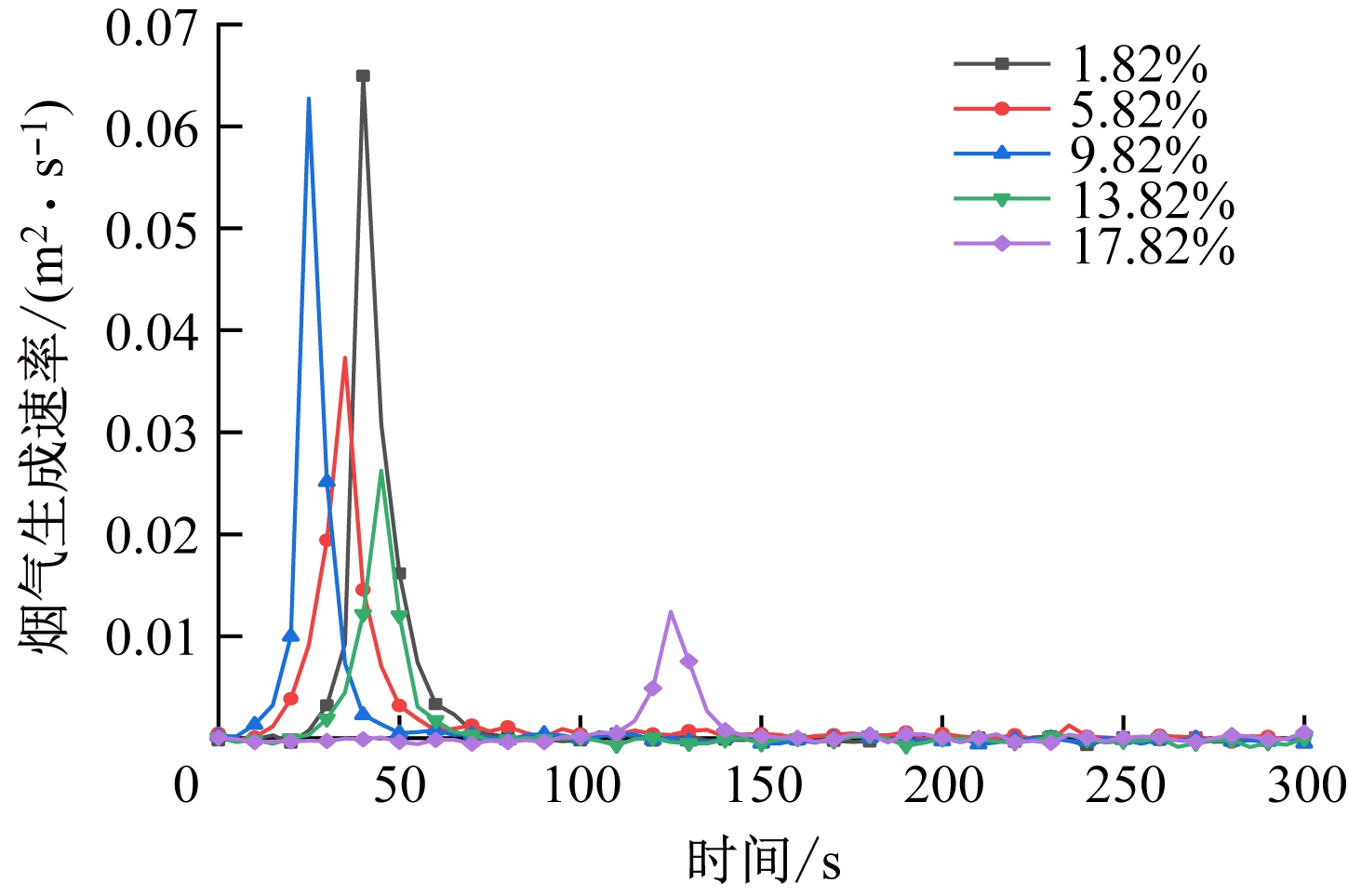
图4 不同含水率煤样烟气生成速率
Fig.4 Flue gas generation rate of coal samples with different moisture content
不同含水率煤样总烟释放量如图5所示。可看出煤样总烟释放量随含水率增大先减小后增大再减小,煤样总烟释放量从大到小对应的含水率排序为1.82%>9.82%>5.82%>13.82%>17.82%;当含水率大于9.82%时,煤样水分含量越高,总烟释放量越低。
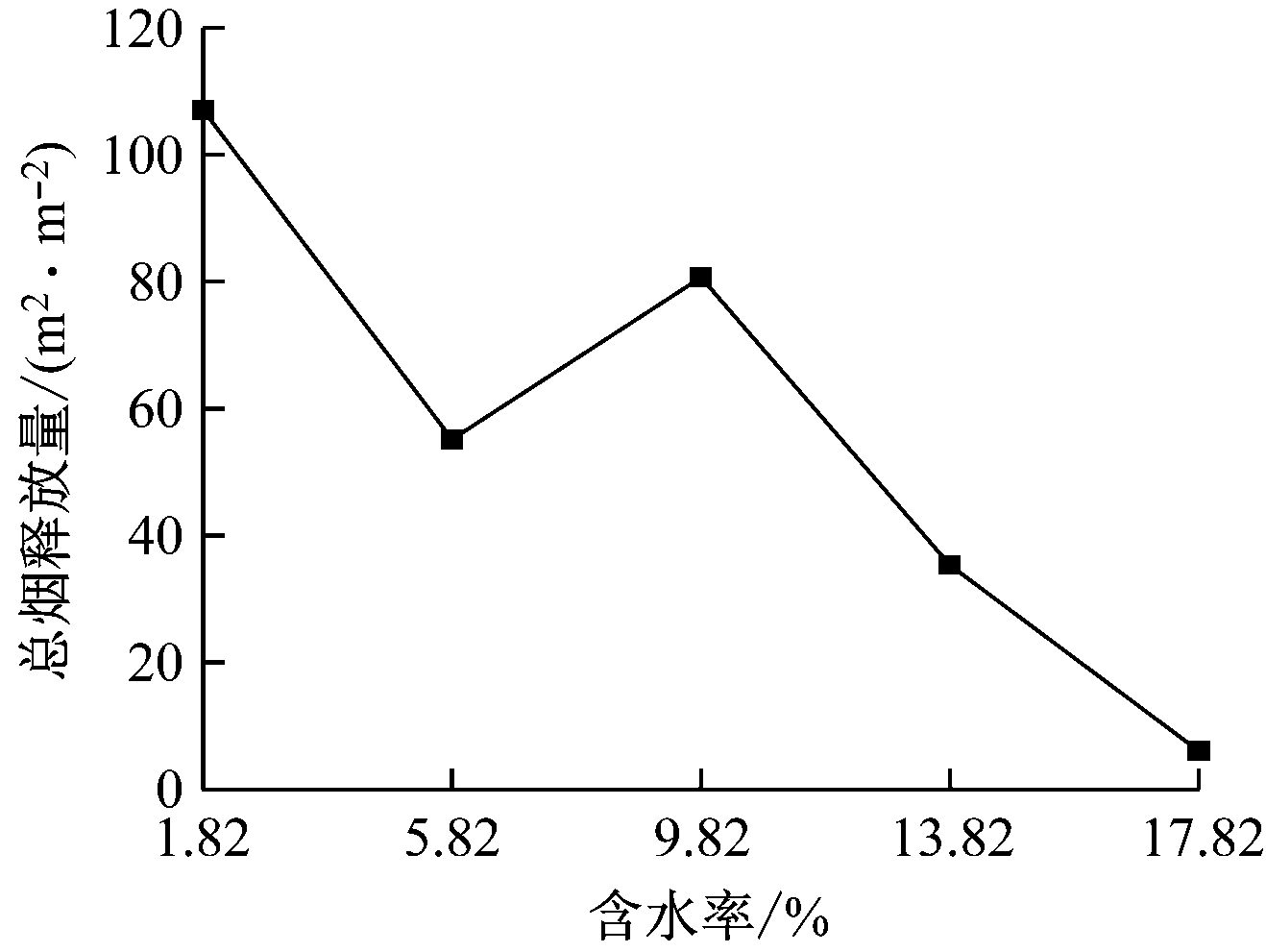
图5 不同含水率煤样总烟释放量
Fig.5 Total smoke release of coal samples with different moisture content
2.4 CO生成速率
不同含水率煤样CO生成速率如图6所示。可看出不同含水率煤样CO生成速率呈先急剧增大后减小再缓慢增大的趋势;在燃烧初期,CO生成速率峰值从大到小对应的含水率排序为9.82%>1.82%>13.82%>5.82%>17.82%;在燃烧后期,含水率17.82%的煤样CO生成速率远高于其余煤样,含水率5.82%的煤样CO生成速率最低,这是由于含水率17.82%的煤样主要进行燃烧反应,含水率5.82%的煤样主要进行气化反应,而燃烧反应产生CO较多。
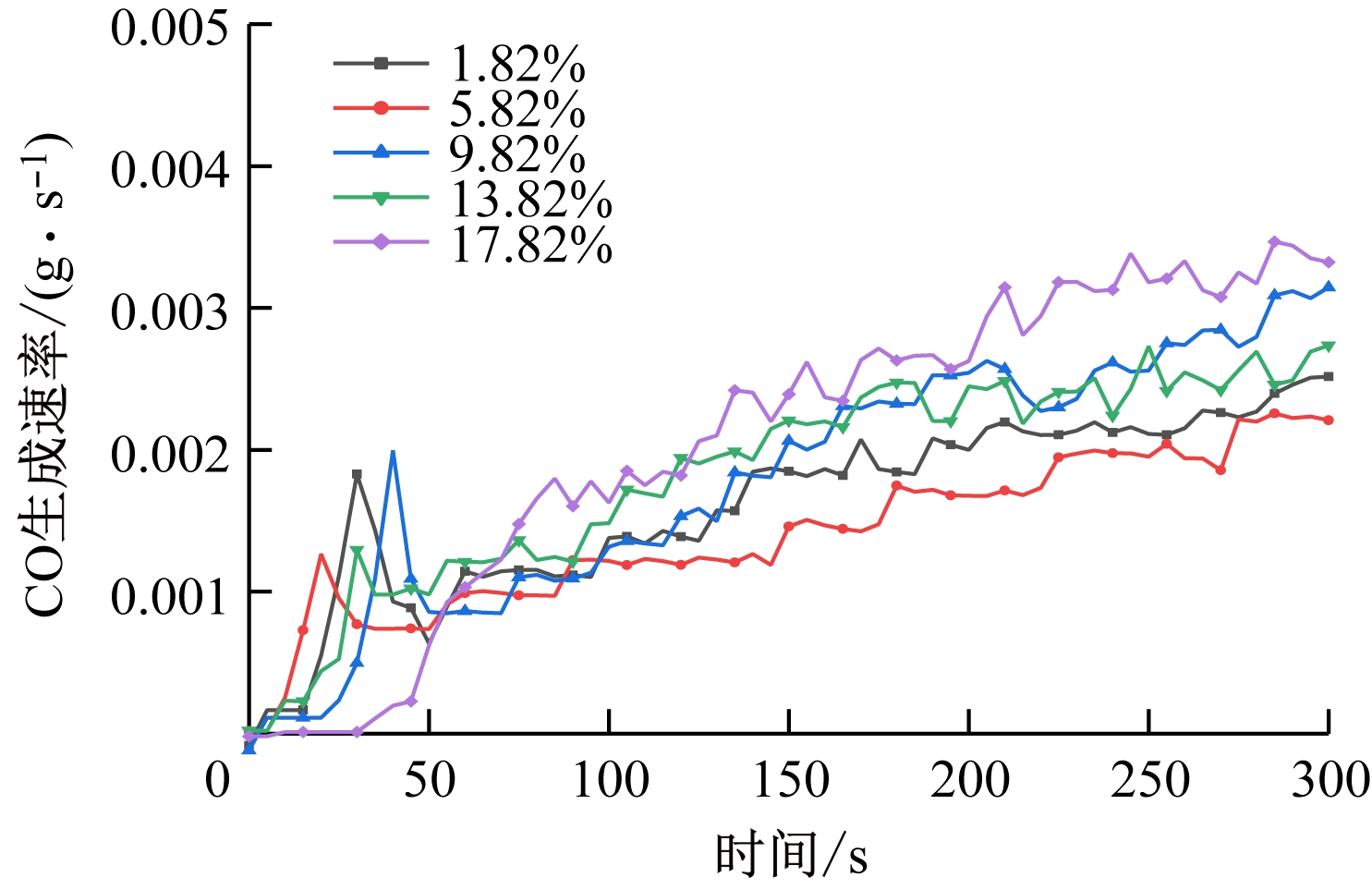
图6 不同含水率煤样CO生成速率
Fig.6 CO generation rate of coal samples with different moisture content
3 煤样燃烧效率评价
为更全面地分析不同含水率煤样燃烧效率,引入火灾性能指数和火灾增长指数。火灾性能指数越高、火灾增长指数越低,煤样燃烧效率越低[15]。
FFPI=TTTI/PPHRR
(1)
FFGI=PPHRR/TTTP
(2)
式中:FFPI为火灾性能指数,m2·s/kW;TTTI为点燃时间,s;PPHRR为热释放速率峰值,kW/m2;FFGI为火灾增长指数,kW/m2·s;TTTP为热释放速率达到峰值的时间,s。
不同含水率煤样的火灾性能指数和火灾增长指数如图7所示。可看出含水率17.82%的煤样火灾性能指数最高、火灾增长指数最低;煤样燃烧效率从大到小对应的含水率排序为9.82%>5.82%>1.82%>13.82%>17.82%。
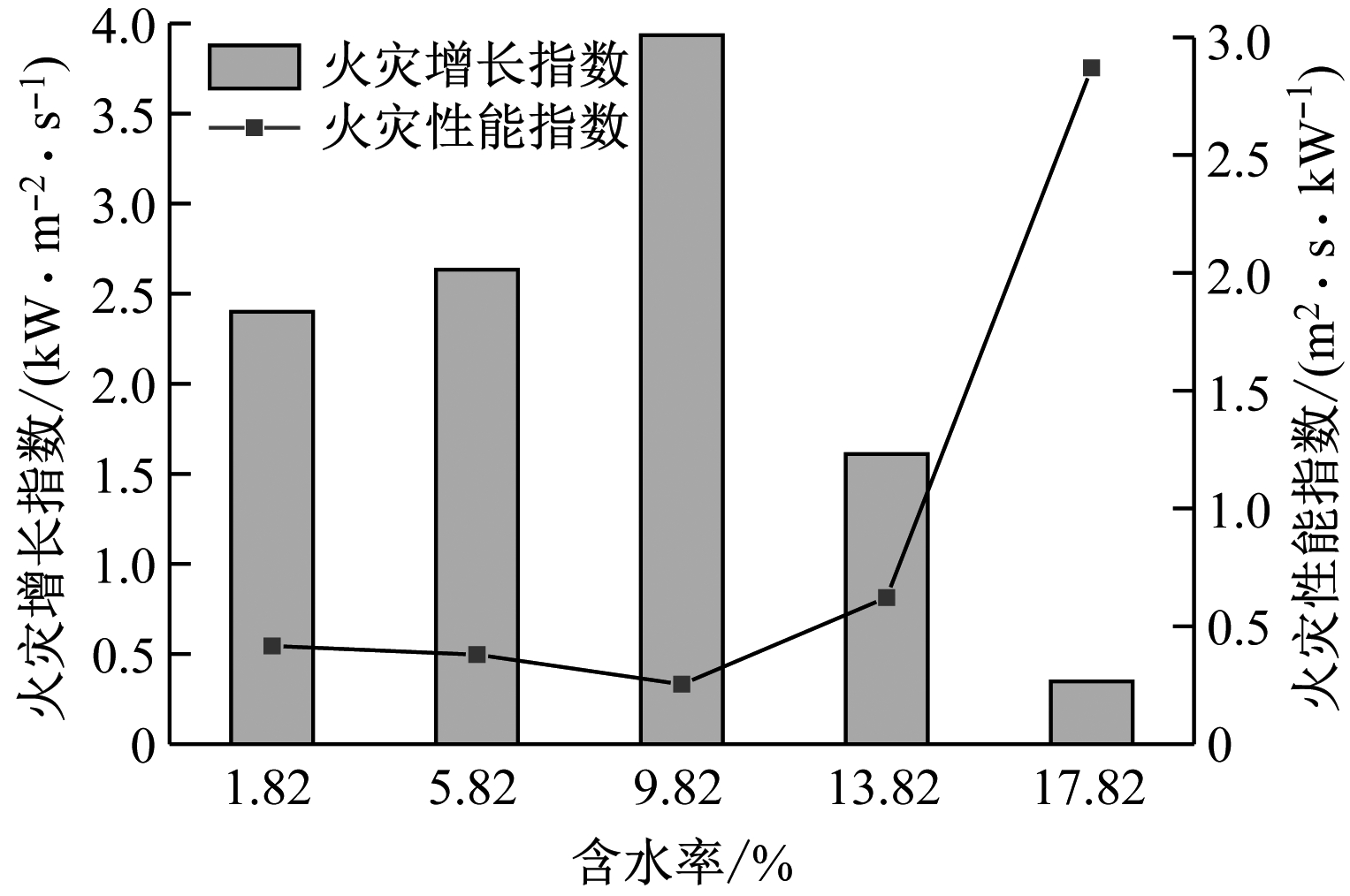
图7 不同含水率煤样火灾性能指数和火灾增长指数
Fig.7 Fire performance index and fire growth index of coal samples with different moisture content
4 结论
(1) 煤样点燃时间随着含水率增大先减少后增加,煤样点燃时间从长到短对应的含水率排序为17.82%>13.82%>1.82%>5.82%>9.82%;煤样热释放速率峰值随含水率增大先减小后增大再减小,煤样热释放速率峰值从大到小对应的含水率排序为9.82%>1.82%>5.82%>13.82%>17.82%;煤样总热释放量、烟气生成率和总烟释放量随含水率增大先减小后增大再减小,其从大到小对应的含水率排序为1.82%>9.82%>5.82%>13.82%>17.82%;在燃烧后期,含水率5.82%的煤样CO生成速率最低,含水率17.82%的煤样CO生成速率最高,高水分含量会增大CO产率;煤样燃烧效率从大到小对应的含水率排序为9.82%>5.82%>1.82%>13.82%>17.82%。
(2) 适当的水分含量可提高煤的燃烧性能,应选择含水率为5.82%~9.82%的煤,可缩短煤点燃时间,减小烟气生成率、总烟释放量和CO生成速率,提高热释放速率和燃烧效率。
[1] 梁运涛,王树刚,蒋爽,等.煤炭自然发火介尺度分析:从表征体元宏观模型到孔隙微观模型[J].煤炭学报,2019,44(4):1138-1146.
LIANG Yuntao,WANG Shugang,JIANG Shuang,et al.Analysis of mesoscale in coal spontaneous combustion:from macro-model of representative elementary volume scale to micro-model of pore scale[J].Journal of China Coal Society,2019,44(4):1138-1146.
[2] 赵增玉.煤矿易发安全隐患及预防措施[J].工矿自动化,2016,42(6):25-29.
ZHAO Zengyu.Hidden dangers in coal mine and their preventive measures[J].Industry and Mine Automation,2016,42(6):25-29.
[3] 王德明.煤矿热动力灾害及特性[J].煤炭学报,2018,43(1):137-142.
WANG Deming.Thermodynamic disaster in coal mine and its characteristics[J].Journal of China Coal Society,2018,43(1):137-142.
[4] 沈旭升,缪正清,韩宝驹.水分对褐煤燃烧特性及锅炉性能的影响[J].锅炉技术,2020,51(1):42-47.
SHEN Xusheng,MIAO Zhengqing,HAN Baoju.Influences of water content on coal combustion behavior and performance of lignite-fired boiler[J].Boiler Technology,2020,51(1):42-47.
[5] 李宛鸿,褚廷湘,刘文德,等.外加水分含量对煤低温氧化影响试验研究[J].中国安全科学学报,2019,29(9):84-89.
LI Wanhong,CHU Tingxiang,LIU Wende,et al.Experimental study on effects of plus water content on low-temperature oxidation of coal[J].China Safety Science Journal,2019,29(9):84-89.
[6] 李锋,安世岗,邢真强.水浸煤孔隙结构及自燃特性试验研究[J].煤炭科学技术,2019,47(增刊2):208-212.
LI Feng,AN Shigang,XING Zhenqiang.Experimental study on pore structure and spontaneous combustion characteristics of submergerd coal[J].Coal Science and Technology,2019,47(S2):208-212.
[7] 王亚超,袁泉,肖旸,等.水分对白皎无烟煤氧化过程放热特性的影响[J].西安科技大学学报,2018,38(5):721-727.
WANG Yachao,YUAN Quan,XIAO Yang,et al.Effect of moisture on exothermic characteristics of oxidation process of Baijiao anthracite[J].Journal of Xi'an University of Science and Technology,2018,38(5):721-727.
[8] 贾廷贵,娄和壮,刘剑,等.不同水分含量煤自燃过程热特性实验研究[J].煤炭学报,2020,45(增刊1):346-352.
JIA Tinggui,LOU Hezhuang,LIU Jian,et al.Experimental study on thermal characteristics of spontaneous combustion process of coal with different moisture[J].Journal of China Coal Society,2020,45(S1):346-352.
[9] 徐长富,樊少武,姚海飞,等.水分对煤自燃临界温度影响的试验研究[J].煤炭科学技术,2015,43(7):65-68.
XU Changfu,FAN Shaowu,YAO Haifei,et al.Experiment study on moisture affected to critical temperature of coal spontaneous combustion[J].Coal Science and Technology,2015,43(7):65-68.
[10] 翟小伟,蒋上荣,王博.水分对煤孔隙结构及自燃特性的影响研究现状[J].煤矿安全,2020,51(2):38-42.
ZHAI Xiaowei,JIANG Shangrong,WANG Bo.Research status of influence of water content on pore structure and spontaneous combustion characteristics of coal[J].Safety in Coal Mines,2020,51(2):38-42.
[11] 秦波涛,仲晓星,王德明,等.煤自燃过程特性及防治技术研究进展[J].煤炭科学技术,2021,49(1):66-99.
QIN Botao,ZHONG Xiaoxing,WANG Deming,et al.Research progress of coal spontaneous combustion process characteristics and prevention technology[J].Coal Science and Technology,2021,49(1):66-99.
[12] 金永飞,郭军,文虎,等.煤自燃高温贫氧氧化燃烧特性参数的实验研究[J].煤炭学报,2015,40(3):596-602.
JIN Yongfei,GUO Jun,WEN Hu,et al.Experimental study on the high temperature lean oxygen oxidation combustion characteristic parameters of coal spontaneous combustion[J].Journal of China Coal Society,2015,40(3):596-602.
[13] 张培,王文才,林俊森.露头煤层自燃相似实验研究及热释放速率计算[J].工业安全与环保,2017,43(1):44-46.
ZHANG Pei,WANG Wencai,LIN Junsen.Similar experiment research and calculation of heat release rate on outcrop coal seam spontaneous combustion[J].Industrial Safety and Environmental Protection,2017,43(1):44-46.
[14] 王康,刘运传,孟祥艳,等.锥形量热仪测量材料热释放速率的影响因素分析[J].消防科学与技术,2018,37(4):449-452.
WANG Kang,LIU Yunchuan,MENG Xiangyan,et al.Analysis on the influence factors of heat release rate tested by cone calorimeter[J].Fire Science and Technology,2018,37(4):449-452.
[15] 秦波涛,宋爽,戚绪尧,等.浸水过程对长焰煤自燃特性的影响[J].煤炭学报,2018,43(5):1350-1357.
QIN Botao,SONG Shuang,QI Xuyao,et al.Effect of soaking process on spontaneous combustion characteristics of long-flame coal[J].Journal of China Coal Society,2018,43(5):1350-1357.
